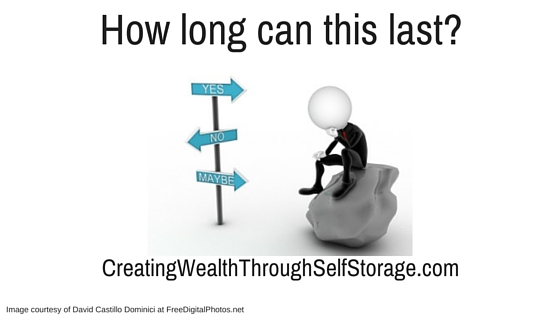“How long can this expansion of self storage last?”
“Is there a self storage bubble forming now?”
Those seemed to be the questions on everyone’s mind at the Inside Self Storage Convention in Las Vegas this year.
Here is my take away. If you are basically pessimistic and you lean towards the conservative side, all the data points to yes, there is a dark cloud of over building coming!
If you tend to be more positive and see the glass half full, the same data shows to we have a number of years before we have to worry about a bubble bursting.
Ultimately you have to figure out the dynamics of the markets you are going to grow in and make that determination for yourself.
Here are some of the facts everyone agreed on:
- For the first time in the history of this self storage product, all five REITS (yes there is a new public REIT in the world of Self Storage, NSA) have occupancy rates over 90%.
- NARIET reports that self storage was the second highest performing class of REITS in the last year, only behind Regional Malls, and was the highest performing REIT in the last five years running.
- In 2015 there were approximately 500 new self storage facilities built and brought on line.
- In 2016 it is anticipated that 600 newly constructed will come on line, and in 2017, it is estimated 900 will.
Here is what was quietly said, or perhaps I just didn’t hear anyone saying it very loudly:
- To keep up with population growth alone, there needs to be 500 new facilities coming on per year.
- From 2008 to 2013, there were so few new facilities brought on line, that population growth alone can explain the over 90% occupancy rates everyone is experiencing.
- If you use the spread of the 10-year treasury bill and self storage CAP rates on existing sales as an index, it appears as if we have hit bottom (or top, depending on how you look at it) in high self storage pricing for existing facilities.
Here’s the thing: none of this matters in, let’s say, the Louisville market where we have a new facility built and in lease up mode. The only thing that matters is what the supply/demand for self storage is in the market area that facility serves.
That’s the good news about this product.
In our facilities an average 80% to 86% of our customers come from 2 zip codes, with the exception of one expressway exposed facility.
This is a sub-market product.
This is great news because the supply/demand can easily be quantified. The barrier of entry is the risk factor you can quantify for new product entering the market you are considering.
This is great news. No other product offers this to an investor or a developer.
Get feasibility reports. Period.
Take advantage of what this product is and the benefits it has. Get feasibility reports.
Now from all the the data I gathered and all that I heard, as I rub my crystal ball, here is what I predict:
- Occupancy rates will stay high (over 90%) for the next 3 years, then will slowly creep back to closer to 85%.
- Therefore, run Proforma at 85% to 88% long term stabilized occupancy.
- What will cause the eventual slow down of self storage acquisitions and the construction boom in approximately 3 years will be a more gradual cooling of the economy and not a cataclysmic event like 2008.
- Some sub-markets will be overbuilt and new investors in the business will suffer slower absorption and below expected rates and stabilized occupancy.
- In my opinion current markets that have close to a level supply/demand now (25,000 square feet or less of demand) and a low barrior of entry are the markets to pass on.
- Also markets where one company owns 15% or more of the product in the sub-market you are looking at.
Nothing of what I have said or reported is gospel. It’s just my interpretation of all the facts I saw at this years ISS convention.
Ultimately, you have to determine for yourself, because as entrepreneurs and owners who create our own futures, we are 100% responsible for what happens to us and we can never blame a market. The market doesn’t care.
I just wanted to demonstrate how someone can take a set of raw facts, then sit down and use the data strategically to determine one’s actions for the upcoming year or so.
That is why I love these conventions, why I love this industry, and why I like working with the smaller investors in this industry.
Now there are only two questions left.
Am I basically a pessimist or optimist?
Are you basically a pessimist or optimist?




After construction, in a good location, how long should we expect it to take to each 80 or 90% occupancy?